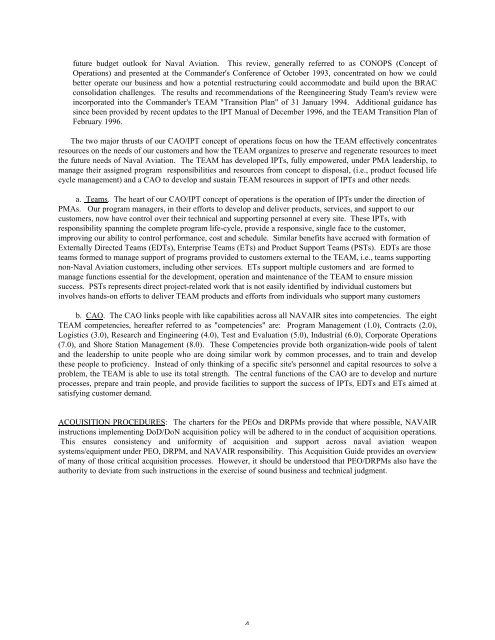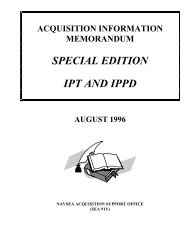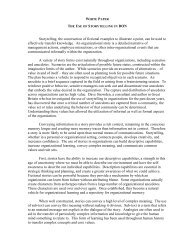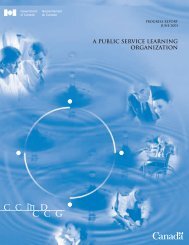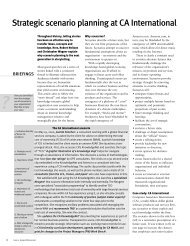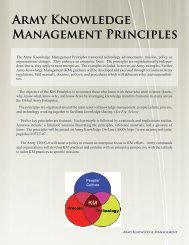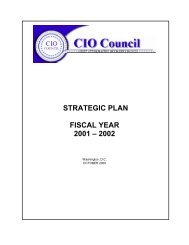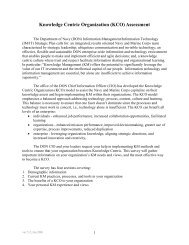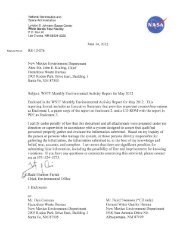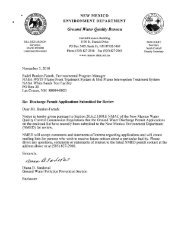NAVAL AVIATION SYSTEMS - NASA Wiki
NAVAL AVIATION SYSTEMS - NASA Wiki
NAVAL AVIATION SYSTEMS - NASA Wiki
Create successful ePaper yourself
Turn your PDF publications into a flip-book with our unique Google optimized e-Paper software.
future budget outlook for Naval Aviation. This review, generally referred to as CONOPS (Concept of<br />
Operations) and presented at the Commander's Conference of October 1993, concentrated on how we could<br />
better operate our business and how a potential restructuring could accommodate and build upon the BRAC<br />
consolidation challenges. The results and recommendations of the Reengineering Study Team's review were<br />
incorporated into the Commander's TEAM "Transition Plan" of 31 January 1994. Additional guidance has<br />
since been provided by recent updates to the IPT Manual of December 1996, and the TEAM Transition Plan of<br />
February 1996.<br />
The two major thrusts of our CAO/IPT concept of operations focus on how the TEAM effectively concentrates<br />
resources on the needs of our customers and how the TEAM organizes to preserve and regenerate resources to meet<br />
the future needs of Naval Aviation. The TEAM has developed IPTs, fully empowered, under PMA leadership, to<br />
manage their assigned program responsibilities and resources from concept to disposal, (i.e., product focused life<br />
cycle management) and a CAO to develop and sustain TEAM resources in support of IPTs and other needs.<br />
a. Teams. The heart of our CAO/IPT concept of operations is the operation of IPTs under the direction of<br />
PMAs. Our program managers, in their efforts to develop and deliver products, services, and support to our<br />
customers, now have control over their technical and supporting personnel at every site. These IPTs, with<br />
responsibility spanning the complete program life-cycle, provide a responsive, single face to the customer,<br />
improving our ability to control performance, cost and schedule. Similar benefits have accrued with formation of<br />
Externally Directed Teams (EDTs), Enterprise Teams (ETs) and Product Support Teams (PSTs). EDTs are those<br />
teams formed to manage support of programs provided to customers external to the TEAM, i.e., teams supporting<br />
non-Naval Aviation customers, including other services. ETs support multiple customers and are formed to<br />
manage functions essential for the development, operation and maintenance of the TEAM to ensure mission<br />
success. PSTs represents direct project-related work that is not easily identified by individual customers but<br />
involves hands-on efforts to deliver TEAM products and efforts from individuals who support many customers<br />
b. CAO. The CAO links people with like capabilities across all NAVAIR sites into competencies. The eight<br />
TEAM competencies, hereafter referred to as "competencies" are: Program Management (1.0), Contracts (2.0),<br />
Logistics (3.0), Research and Engineering (4.0), Test and Evaluation (5.0), Industrial (6.0), Corporate Operations<br />
(7.0), and Shore Station Management (8.0). These Competencies provide both organization-wide pools of talent<br />
and the leadership to unite people who are doing similar work by common processes, and to train and develop<br />
these people to proficiency. Instead of only thinking of a specific site's personnel and capital resources to solve a<br />
problem, the TEAM is able to use its total strength. The central functions of the CAO are to develop and nurture<br />
processes, prepare and train people, and provide facilities to support the success of IPTs, EDTs and ETs aimed at<br />
satisfying customer demand.<br />
ACQUISITION PROCEDURES: The charters for the PEOs and DRPMs provide that where possible, NAVAIR<br />
instructions implementing DoD/DoN acquisition policy will be adhered to in the conduct of acquisition operations.<br />
This ensures consistency and uniformity of acquisition and support across naval aviation weapon<br />
systems/equipment under PEO, DRPM, and NAVAIR responsibility. This Acquisition Guide provides an overview<br />
of many of those critical acquisition processes. However, it should be understood that PEO/DRPMs also have the<br />
authority to deviate from such instructions in the exercise of sound business and technical judgment.<br />
4


